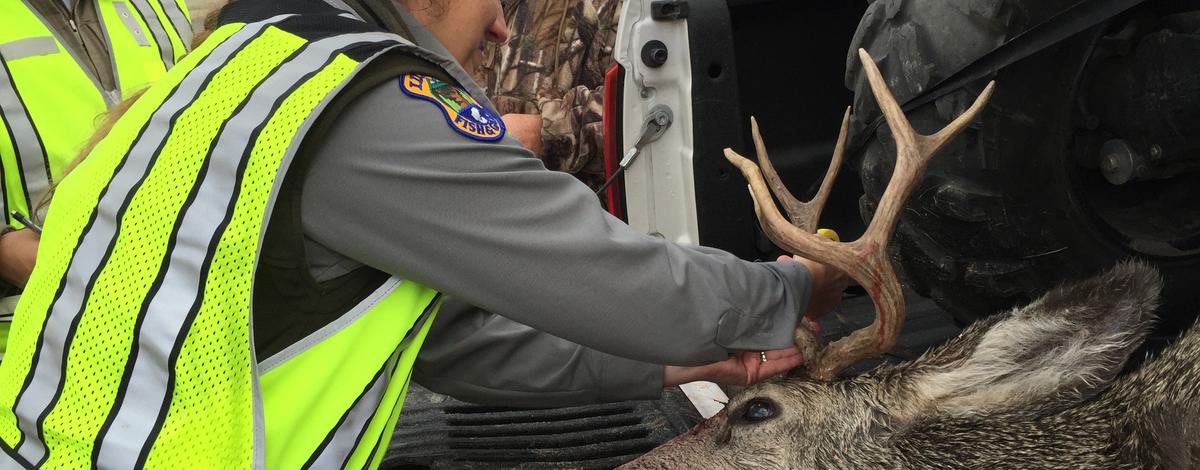Oct. 20-21 was the second weekend of deer hunting and the first weekend of elk hunting in many parts of the state. Fish and Game was running its check stations in most of its traditional areas and adding new ones as well.
While its difficult to judge how the hunting season is going based on one weekend of check stations, there are some interesting details about the hunting season so far. In many parts of the state, it’s been warm and sunny well into fall, which typically isn’t the best conditions for hunters to be successful.
Harvest rates at check stations over the Oct. 20-21 weekend varied wildly, from a low of less than 1 percent at a Panhandle check station to 26 percent success at a check station in the Salmon Region.
Fish and Game personnel are seeing a higher percent of yearling deer in the harvest this year because of good fawn survival last winter. This is just the opposite of last hunting season when yearling numbers were down because fawn survival was poor the previous winter in 2017. Yearlings normally make up one half the harvest on an average year.
Overall, hunter success and deer harvest should be up this year over last year, but results will vary across the state as we predicted.
Elk hunter success should be similar to last year.
Deer and elk hunting continues through October and into November and even December in some areas, so there’s still a lot of hunting available.
Here are some stats and comments from the check stations over the Oct. 20-21 weekend.
Southwest Region
Walters Ferry: Warm, 70 degrees, 10 percent success rate out of 254 deer and elk hunters (mostly deer). This check station serves hunting units that are mostly limited to 2 point deer, so 83 percent of harvested deer were yearlings.
Marsing: Hunter success was 9.5 percent success, 100 percent yearlings (There are two-point only restrictions in most units the check station serves) Hunters commented on the number of hunters they saw, and how few deer they observed.
Warren Wagon Road (McCall): New check station for 2018, 222 hunters had three elk, 13 mule deer and four whitetails. Overall success 9 percent. Sunny weather and warm temperatures. Many hunters reported not seeing any game and blamed it (mostly) on the weather, with also a few wolf complaints. They also reported seeing lots of people and camps.
Brundage Mountain Road (McCall): New check station for 2018, 120 hunters, three elk, three mule deer and one whitetail. Comments were similar to Warren Wagon check station.
Upper Snake Region
Ririe/Sage Junction: Hunter numbers up 20 percent over previous year (same weekend), success rate 14 percent, but down from previous year. Triple number of whitetails (three in 2017, nine in 2018) and 56 percent of the harvested deer were yearlings.
Overall hunter numbers and deer harvest increased, while harvest of elk was down when compared to second weekend last year. Deer and elk body condition was good.
Yearling harvest was much higher than last year making up 56 percent of harvest with majority of this from Sage Junction check station (65% of deer harvested where yearlings).
Antlerless mule deer harvest was high at Sage Junction check station with 32 percentr of harvested mule deer being antlerless. Mule deer harvest of four-points or larger bucks was good at 24 percent of the harvest, but lower than in 2017.
Elk harvest was slightly down from 2017 with 36 percent were six points or better and more than half the elk checked were antlerless (nearly double from 2017).
Southeast Region
Port of entry, Interstate 15: Total hunters up 5 percent, success rates for elk and deer up 42 percent and 48 percent respectively. 19 percent overall success for deer and elk hunters, up from 14 percent for same weekend in 2017. Half of deer harvested were yearlings.
In general, hunters reported observing lots of does and very few bucks. Bucks that were observed were small.
Panhandle
Enaville: Low numbers continued, out of 308 hunters, only three elk harvested, no deer. Success rate less than 1 percent. Conditions were hot and dry. Highs in the mid-60s and sunny. Hunters complained about wolves throughout Unit 4. This check station had a similar low harvest rate opening weekend of deer season.
St. Maries: Number of hunters increased by 40 percent compared with last year and success rates were about the same as last year with between 7 percent and 8 percent success rate. Overall harvest was relatively small with 16 elk, one mule deer and three whitetails coming through the check station. Weekend was sunny, clear and temperatures around 65 degrees. Complaints about non-resident hunters, too many hunters and low grouse numbers.
Salmon Region
Carmen: Among the highest success rates in the state with 26 percent of hunters coming through the check station had game. Out of 241 hunters, harvest included 14 elk and 48 mule deer. Elk harvest was 55 percent above 2017 and deer 92 percent above 2017.
Stephens Gulch (Challis): Hunter numbers were down 32 percent compared with 2017 (344 vs 231), elk harvest was also down 40 percent, but mule deer harvest was up by 29 percent, and total success rate was 19 percent. Harvest included 44 animals (12 elk, 31 mule deer and one whitetail) for the weekend and 45 in 2017. Hunters said they were not seeing much except up high. Harvest distribution seemed to be patchy. Very high success in some areas and very low success in adjacent areas.

